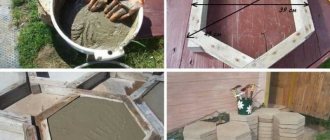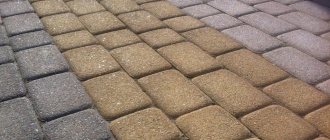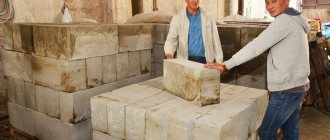When creating a tile solution with your own hands, you need to correctly calculate the ratio of all the components used, choose the appropriate brand of building materials and study the production recipe.
Great importance is attached to the type of raw materials, work environment, weather and other factors. However, there are universal methods that allow you to prepare the right mixture in a short time.
Technologies for manufacturing paving slabs
The main ones are vibration casting and vibration pressing. The first is making a solution and pouring it into molds that are installed on a vibrating table. The latter got its name only because it vibrates with a small amplitude. This allows the concrete solution to be shaken and made denser, which makes the finished product denser.
Making tiles on a vibrating table
The second technology is based on pressing the mixture, which is placed into molds. For this purpose, special equipment is used, the use of which increases the cost of paving slabs. But it is this method that saves cement through the use of a semi-dry method. That is, the solution is mixed with a low water content. In addition, tiles and paving stones made by vibration pressing have higher strength and geometric dimensional accuracy.
But, since the task is to produce paving slabs with your own hands, we will have to talk about the first technology - vibratory casting.
Materials used, tools
To create a paving surface with your own hands using the vibratory casting method, you will need the following materials:
- aggregate;
- cement sand;
- plasticizing agent;
- dye;
- reinforcing fiber;
- mold release agent;
- water.
To work you will need:
- concrete mixer;
- vibrating device with a flat surface;
- molds (it’s better to buy ready-made ones);
- large container filled with warm water.
In addition, you should have with you:
- strong 10-liter bucket;
- shovel;
- Master OK;
- latex gloves.
Return to contents
Types of solutions
The composition of paving slabs consists of two layers: front and base. They are made from two different concretes. A reinforcing frame is laid between them. This can be an ordinary steel mesh or hand-woven pieces of wire.
Concrete pouring process:
- the solution for the front layer is poured into the mold;
- carry out vibration on a vibrating table;
- lay the reinforced frame;
- pour the concrete of the base layer;
- vibration starts again.
No more than half an hour should pass between pouring two different types of concrete. If this happens, then there is a high probability that the paving slabs will simply delaminate during use.
To prevent this from happening, you need to be well prepared for the process of making paving slabs. Namely:
- choose two containers in which two different types of concrete will be prepared;
- cut the mesh into pieces the size of which corresponds to the size of the molds.
After this, you can proceed to the preparation of concrete compositions.
Tile casting
Facing solution
The front surface of paving slabs is constantly exposed to loads during operation. Therefore, it should be the strongest and most wear-resistant plane.
This layer should include high-quality materials:
- cement grade not lower than M500;
- a mixture of crushed stone and sand in a 1:1 ratio, which includes medium-fraction gravel (5-10 mm), sand - preferably river sand;
- water;
- dispersant;
- pigment.
Such concrete is poured into molds in a layer 2 cm thick and vibrates for 2-4 minutes.
Composition and proportions of concrete
Dispersant solution
This is a chemical substance that belongs to the category of surface-active plasticizers. It is added to paving slabs made from concrete to achieve certain product characteristics:
- the front surface is strengthened;
- it becomes glossy;
- the tiles are easily separated from the mold;
- no concrete particles remain on the surfaces of the forms, which reduces cleaning costs;
- concrete becomes more mobile and plastic, which simplifies working with it;
- the color of the paving slabs becomes more pronounced.
The dispersant itself is a white powder. But it is added to concrete only in the form of an aqueous solution. It is prepared in a ratio of 1:4 (reagent-water). The latter should be warm – +50 ℃. The amount of dispersant solution in concrete is 1 liter per 50 kg of cement. Manufacturers guarantee that the prepared aqueous solution can be stored for 5 days without changing its technical characteristics.
Concrete dispersant is an active chemical substance. Therefore, when working with it, you must strictly adhere to safety rules: protective gloves on your hands, glasses on your eyes, a mask on your face.
Making paving slabs with your own hands. You can read about this here.
Concrete for laying
Laying paving stones is carried out:
- For sand mixture (bedding, pillow). The method is applicable in dense soils with low groundwater levels and no heaving.
- New concrete base: sand, peat, bulk soil predominate.
- Existing base: there was a need to refresh the old dilapidated concrete surface with paving stones.
Sand base
- The soil layer is removed.
- Sprinkling is carried out with crushed stone (gravel) with a fraction of up to 20–25 mm.
- A cushion of coarse sand is formed. You can apply the grus at home.
- Border stones are installed on the mortar.
- The tiles are being laid. The stones are installed close to each other in a checkerboard pattern.
- The top layer is filled with fine sand. Excess mixture is removed with a stiff brush.
New concrete
Stages of work:
- A pit is formed and the fertile layer is excavated. The depth should be at least 40~50 cm.
- Concrete proportions:
- Portland cement PC-400 – 1 share;
- construction sand – 2.5 (1.5) shares, pedestrian path (car);
- crushed stone – 4 (2.5) shares, sidewalk (vehicle zone).
- A curb stone is installed and fixed to sand-cement mortar. Drainage grooves are made on the external sides to remove precipitation or melt water.
- A cushion of crushed stone with a fraction of up to 25~30 mm is poured. Leveled and compacted using a vibrating platform. Reinforcing mesh is laid under the parking lot.
- The concrete mixture is diluted and placed on the prepared base. After 3~4 meters, a transverse thermal joint is installed from a plank up to 10~15 mm thick. The surface is formed and compacted with a vibratory screed (wide strips) or manually - for garden paths.
- It is advisable to cover the fresh surface with plastic film. This will eliminate premature drying. Cement hydration will proceed as planned.
Example of mixing a mixture for a surface layer
The composition is mixed in the following sequence:
- First, the gravel mixture is mixed with cement in a ratio of 2:1. But first of all, half of the crushed stone with sand is added to the composition. After thorough mixing with cement, the second half is added.
- Water is pouring in. The solution is mixed.
- A dispersant is added, pre-mixed with the required amount of water.
- A pigment is added, which is also pre-diluted with water. Usually this is 1 liter. The amount of dye should not exceed 5% of the volume of the total concrete being prepared.
The material is stirred until it reaches a creamy consistency and the pigment colors the mixture evenly. But not less than 10 minutes. If the color of the solution is not satisfactory, then there is still time to make adjustments - make it more saturated or dull. That is, add pigment or other components accordingly.
As soon as the concrete for the front layer of paving slabs is ready, it is poured into a clean container. There is no need to use the mixture right away or pour it into molds. It is necessary to prepare a second solution.
Price
Construction work itself is an expensive business, and if you are to begin construction work on laying a sidewalk, then you need to have a certain financial reserve behind you. Of course, buying all the elements separately and preparing them yourself will save your finances a little. Read about plastic tiles in the country at this link.
On average, the cost of cement mortar per 1 cubic meter. a meter will cost you from 3,000 rubles to 4,000 rubles.
But how much it will cost you to buy ready-made cement mortar is a subjective matter, as it depends on the brand of cement mortar, its components and class.
To summarize, it is worth noting that laying paving slabs, like any other construction work, requires certain knowledge and skills. If you are not going to hire specialists, but want to do everything yourself, then you need to approach the issue responsibly and carefully. Read about the technology of laying paving stones in this article.
An example of preparing a mixture for the main layer
Before mixing, it is necessary to wash the insides of the concrete mixer drum. You can just pour water and twist it. There is no need to drain it. The cement and gravel mixture is poured directly into the drum.
After a few minutes of work, add plasticizer dissolved in water, if purchased in powder form. If it is a liquid, then it is poured straight from the container. Here it is important to strictly follow the quantity to be filled, which the manufacturer indicates on the packaging. You should not reduce or increase it - this will lead to changes in the characteristics of concrete.
While the material for the base layer of paving slabs is being mixed in the drum of the concrete mixer, you can begin to pour the solution for the face layer into the molds. The pouring thickness is 2 cm. After which the vibrating table is turned on for 3 minutes.
Pouring concrete into molds
Concrete compaction has occurred. The vibration table turns off. A reinforcing mesh is laid on top of the concrete. The finished concrete composition for the main layer of paving slabs is poured from the concrete mixer drum into a container. It is placed with shovels into a mold, where there is room for the solution. The mixture needs to be laid a little more, because after vibration and compaction the material will “settle”.
The vibrating table turns on again and works until the concrete in the forms is level with their edges. At this moment, air comes out of the cement-gravel composition, which, after the concrete hardens, reduces its quality characteristics: strength and wear resistance. It's all about the air bubbles remaining inside the solution. They reduce the density of the mixture, and, accordingly, the strength of the entire structure.
Pavement laying process
The basis for the tiles can be a dry cement-sand structure, or the required volume of concrete. The first option is suitable for paths that are not subject to heavy loads, and the second is for street routes along which cars can travel.
Algorithm for cladding:
- A pit about 10 cm deep is dug into which crushed granite stone is poured. It is carefully compacted.
- Then the sand-cement composition (4:1) is distributed. The liquid is poured in a volume equal to part of the cement.
- Tiles are laid on top.
The cycle of actions is repeated for small areas. It is optimal to lay out up to 1 square meter at a time. This is enough to make the sidewalk as smooth as possible.
Purchase of original goods from Bauff
All main building materials are presented in our product catalogue. Leave a request through the shopping cart, or call the number from the “Contacts” section to discuss the details of the order with competent managers. They can provide consulting support not only on the blog, but also by telephone. All clients from Moscow and the Moscow region are offered the best payment and delivery conditions. Be sure to leave your own feedback to help us improve our service and other aspects of our business. Waiting for you!











